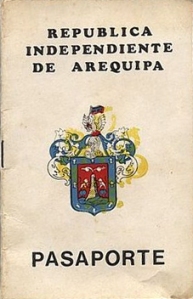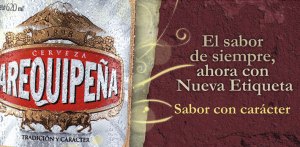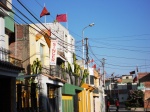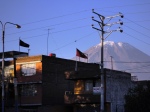Arequipa, AKA La Ciudad Blanca (The White City), is the proudest small city in the world.
In Early Latin America: A History of Colonial Spanish America and Brazil, James Lockhart writes:
Not very far beneath the surface of Iberian reality lay the city-state, the basic entity of Mediterranean civilization immemorial. Nationality was still fluid, distant, and easily undermined by dynastic change and conflict. Everywhere they went, the early modern Iberians gave more importance to provinciality and less to nationality than one might expect. Anyone from the home province was a friend, anyone from elsewhere was an outsider. Again and again political alliances and antagonisms in the New World were based on provincial origins. The province, the city, and the neighborhood were crucial reference points in helping individuals to define themselves in relation to others. Nothing but family had as strong a hold on the emotions of Iberians or was as essential to their sense of identity as regionalism, the love of what was later called the patria chica (home province or town).
Here we see that regional loyalty being stronger than national pride is a throwback to feudal Spain and the Iberian peninsula. You see that regionalism, or provincialism, throughout Latin America. The strongest provincialism in Colombia would be the paisas of Medellin and Antioquia. But I haven’t seen anything like Arequipa pride. The paisas got nothing on the Southern Peru highlanders. Arequipeños used to have their own passport!
 There’s a t-shirt they sell in the tourist areas of Arequipa that says “Yo peruano? Arequipeño CARAJO” – TRANSLATION: Me Peruvian? Arequipeño motherfucker!
There’s a t-shirt they sell in the tourist areas of Arequipa that says “Yo peruano? Arequipeño CARAJO” – TRANSLATION: Me Peruvian? Arequipeño motherfucker!
From this Arequipa pride webpage, “No hay regionalismo, arequipeño es nacionalismo.” It’s not regionalist, it’s nationalist. They aren’t literal separatists like in French Canada, but being officially separate from Lima is a common talking point.
Where does the pride originate?
History
In the late 19th century, Peruvian president Lizardo Montero Flores led a war against Chile. During the war he moved Congress to Arequipa, so it became the official capital of Peru for a short time.
A historic political protest in Arequipa led to the fall of 1950s Peruvian dictator Manuel Odría. The event was brilliantly depicted in Mario Vargas Llosa’s Conversation in the Cathedral. Speaking of Peru’s top literary figure, Mario Vargas Llosa was born in Arequipa. So the locals claim him as their own even though he left for Lima at a young age. Also from Arequipa is Sendero Luminoso leader, Abimael Guzman, who is serving a life prison sentence.
Aside from Arequipa being the temporary capital of Peru and inspiring the pivotal event in the downfall of the Odría dictatorship, Arequipan political pride lies in protests, mining, and the governmental power of Lima. Over 26% of the Peruvian population (8 million) live in Lima. Arequipa is the second city at one million. There aren’t any medium-sized cities to keep Lima in check. So Arequipeños take pride in the power of their protests, their ability to shut down the entire south of Peru to get their way in Lima. The south is rich in mining, but most of the money goes to Lima. In 2001 Arequipan protesters removed cobblestones from the city center streets so trucks couldn’t go in or out.
Food
Another reason for Arequipeño pride is the food. You don’t find typical Peruvian food dominating the menus of traditional restaurants in Arequipa . You’ll find Arequipan food, which is amazing in its own right.
Peleas de Toro
Many Latin American countries feature corrida de toros – bullfights where humans stab and kill the bulls. Arequipa has peleas de toro – where the bulls fight each other. Here’s a look at Arequipa bullfights – bull vs. bull:
And an actual fight:

The Arequipa style of bullfighting was recently added to the logo of the local beer, Arequipeña, for which the slogan is “Hecho con orgullo” – Made with pride. The label always featured the highest peak of Arequipa, El Misti (which I climbed in 2008).
Traditional
Peru has some old-school traditions. When partying with a group, you don’t get your own glass of beer. There’s one glass for everyone (maybe two or more depending on the size of the group). The glass is passed around for everyone to drink from. The next person to receive the glass holds the big bottle of beer. When the person before him finishes his beer, he receives the glass, serves himself, and passes the bottle to the next person. Women don’t hold the bottle. Instead, the bottle jumps to the next male, who serves her.
Arequipa Day
This article was inspired by Arequipa Day, August 15. Peruvian Independence Day, July 28, is a tranquil affair in Arequipa. Arequipa Day, on the other hand, is a chaotic romp of celebration throughout the city.
Here’s the first of a comprehensive, 29-part YouTube playlist on the 2011 corso:
Here’s a shorter clip:
See an itinerary of events on Arequipa Day.
These pictures illustrate how many people hang AQP flags on Arequipa Day.
Carnaval Arequipeño
That’s the song you’ll hear a million times on Arequipa Day. The video features mostly images from Colca Canyon, a major source of AQP pride.
Carnaval Arequipeño is the preferred anthem among the “serranos.”
Upper-estrato Arequipeños prefer El Regreso as their AQP anthem. Less horns, more strings.
El Regreso
This video also has the more urban signature images from Arequipa, mostly the Cathedral.
Next is the official hymn – very old school.








Still putting hands on your “wife”? Funny how that article was erased so fast.
LikeLike
You have to read a real book of peruvian history man.
Arequipa is where my grandfather was born and He was a landlord proud to be from Arequipa and proud to be peruvian.
Arequipa fro long time was a province of Cuzco and they did not accept that so they rose in arms in rebelion of what the Peruvian government located in Lima ruled.
Arequipenos always had this aristocratic sense .They felt they were direct descendants of the spanish conquerors.
My grandfather and his family used to perform that funny event called Presentacion en sociedad to their female daughters . What was a walk by the plaza de armas in a carriage and a formal party in the main club of the arequipena aristocracy.
Peru after the independence was not the same territory we had now. When Simon Bolivar ruled peru he started to giver part to the peruvian territory to the new countries of Ecuador and Colombia and separated el alto Peru and founded a new country Bolivia.
So years after our politicians and miklitary started forces started to recover part of our territory. And they achieved part of it. You have to read what colombians , ecuadorians and bolivians say about that. Colombians got the trapecio de leticia but they lost a lot of the amazonian territory.
Ecuador lost half of what Bilivar and Sucre wanted to give to them.
And about chile we lost the pacific war promoted by U,K, using chile as a puppet they armed chile for long time to prepare the pacific war . It was also the fault of our poñpliticians because we had a civil war during that time . But England prepared with chile that war. They also blocked and finaly confiscated the arrive of three peruvian warships coming from Germany to Peru.
And a lot of Krupp cannons, chile bought warships from england and their navy was trained by english officers in 1876. England wanted our nitrate they realy wanted to take the resources of tarapaca .
James G. Blaine as secretary of state under Presidents James A.
Garfield and Chester Arthur (March-December 1881). Blaine had supported
Peru against Chile in the War of the Pacific (1879-1884), charging that
Chile’s military aggression was encouraged by Great Britain. Hoping to
enhance American trade in Latin America, Blaine criticized British economic
interests in Chile. .
http://www.latinamericanstudies.org/baltimore-affair.htm
The supposed reason to start the was Bolivia’snationalization of British saltpeter companies,
Chilean government invaded the current Antofagasta territory at that time belonged to bolivia, But letters of the war secreatary of chile of the time said the real target was tarapaca the wealthiest territory in nitrates . Brithish compoanies and the government had a resentment because peruvian government elected french companies and a company from new York to exploit the mines of natural nitrates.
English companies and government and chileans provoked the war of the pacific.
During the 80s peruvians supported the argentineans military forces in their war to recover las Malvinas islands against England and chile supported England against Argentina.
England lost a lot more of the patagonia territory and they did not fight, After the war they gave territory to Argentina 7 times , At least Peru fought defending his territory chile just gave territory not shooting a bullet that is coward..
LikeLike
Sorry I meant chile lost more than one million of square kilometers of the patagonia not fighting , and gave more territory that was in their possesion to Argentina one of them they got from bolivia Atacama highlands in 1893 and Argentina pressed them and tchileans scared jus t gave it . The same with more territory from patagonia the last one was in 1998.
chile, Ecuador,and Colombia are the countries that lost most territory in this continent
LikeLike
From what I’ve heard Zulia State and it’s capital city of Maracaibo in Venezuela is know for it’s fierce regional pride and rivalry with Caracas.
LikeLike
Freddy – FYI you can see all deleted articles in an RSS Reader 🙂
Victor – excellent info. I read the AQP stuff to wifey and she agreed with everything.
LikeLike
Sorry about my last comment. I feel like I speak for a few long time readers when I say that I miss the old articles about debauchery. The recent change in tone on this blog has robbed us of the most raw and honest writing available on the net. Your site has provided me with a lot of enjoyment and I thank you for that.
LikeLike
The Beer Thing.
On receiving the glass, tip the froth onto the floor or a handy plate, saucer, cup, etc. Froth is Very Bad Stuff. Or you can tip out the froth when passing the glass Either way, Getting Rid Of Froth is a Very Good Thing, so do it.
You can pour yourself a little beer or a lot but don’t worry, there are more bottles out the back! … or at the Corner Shop …
LikeLike